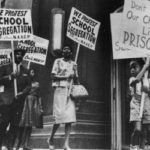In this lesson, students will learn about the events that led to the case In re Gault, and will recognize this case’s importance to juvenile rights and juvenile court proceedings. Students will list those parts of the case that they believe were carried out fairly, and those that they believe were unfair to Gault. Students’ concerns about the case are compared to the actual reasons given by the Supreme Court. The lesson leads naturally into a discussion of due process.
Landmark Supreme Court Cases
When the stories of We the People become cases before the U.S. Supreme Court, and when those cases result in the opinions of the Court, history turns. The ways we think about and live under the Constitution are reflected in the Court’s interpretations in both their historical contexts and their legacies. Some cases — and the Court’s opinions in them — so profoundly alter our constitutional understandings that they can only rightly be called Landmark Cases, markers of where we have traveled as a nation. In this way, the Landmark Cases show us what we have tried, where we have been, and where we are — leaving We the People and future sessions of the Supreme Court to determine how we move forward toward a more perfect union.
Supreme Court Cases On Display
The purpose of this lesson is to have students working in groups of two or three focus of one historic Supreme Court case. Students will understand the process of bringing a case to the Supreme Court, read arguments and discover the importance of this third branch of government. Students will discover the changes these cases made in the lives of people. Then students can determine how the outcome may have affected their lives.
Use Constituting America’s Constitution Archives on U.S. Supreme Court Cases and Justices to support this lesson.
Historic Supreme Court Cases
Students will learn about historic Supreme Court cases and the process of bringing a case to the Supreme Court. They will read arguments and discover the importance of this third branch of government. Students will discover the changes these cases made in the lives of people. From the knowledge they gain, students can determine how the outcome may have affected their lives.
The Power of One Decision: Brown v. Board of Education

When minority students decided to take their challenge of the “separate but equal” doctrine to the Supreme Court, the 1954 decision handed down by the court in Brown v. Board of Education and enforced by the executive branch, changed their lives and America forever. In this lesson plan, based on the Annenberg Classroom video “A Conversation on the Constitution: Brown v. Board of Education,” students gain insight into decision-making at the Supreme Court, learn about the people behind the case, construct a persuasive argument, and evaluate the significance of Brown v. Board of Education.
Landmark Supreme Court Case: Roe v. Wade
The Supreme Court has the power to interpret the Constitution. Its rulings on cases determine the meaning of laws and acts of Congress and the president. Knowing the key decisions of the Supreme Court and the precedents they set is vital in understanding the meaning of laws, how our country has changed over time, and the direction the country is currently headed. In this lesson students will examine the case of Roe v. Wade.
Equal Justice Under Law
In its first constitutional challenge to the equal protection clause of the Fourteenth Amendment, the U.S. Supreme Court decided to hear a case brought by a Chinese immigrant, not an American citizen. Yick Wo believed city ordinances had been unfairly applied to him, so he challenged their constitutionality under the equal protection clause, and took his case all the way to the Supreme Court.
When National Security Trumps Individual Rights
On December 18, 1944, the U.S. Supreme Court handed down one of its most controversial decisions when it upheld the government’s decision to intern all persons of Japanese ancestry (both alien and nonalien) on the grounds of national security. Over two-thirds of the Japanese in America were citizens and the internment took away their constitutional rights. In this lesson, students evaluate the consequences of past events and decisions related to the Supreme Court case Korematsu v. United States (1944). They consider the challenges involved when trying to balance civil liberties and national security during threatening times and reflect on the lessons learned about civil liberties from the justices in the Korematsu case.
The Appointment of Sandra Day O’Connor
The U.S. Constitution grants the President the power to appoint people to a variety of government positions. These appointments require careful thought and consideration since the people can have a great impact on the lives of many Americans during that President’s term. Some appointments need even greater thought and consideration, and those are to the federal judicial system and more importantly, to the Supreme Court of the United States. Justices of the Supreme Court (and other federal courts) serve lifetime appointments. Their rulings as they interpret the Constitution, and other situations as outlined in Article III of the Constitution, can have far-reaching effects for generations. With this awesome power to appoint comes an equally awesome responsibility to make sure that the individuals are the best people for the job. In this lesson, students will examine the appointment of Supreme Court Justice Sandra Day O’Connor, who was also the first female Justice. Students will examine the process by which a President makes the selection and the steps that lead to that person being confirmed by the Senate (or not).
Landmark Supreme Court Cases
In a partnership with the National Constitution Center, Khan Academy talked to constitutional scholars about ten of the most significant Supreme Court cases in history. Teachers can use this lesson as a supplemental resource during their Supreme Court unit to show how constitutional scholars can debate the outcomes of Supreme Court cases, as well as the impact these cases have had on the United States.